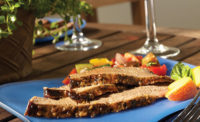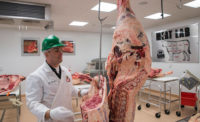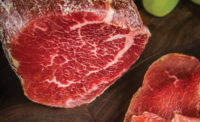Get Real with Beef
A mortadella mentality

The technique for making mortadella is similar to that used in making American-style bologna sausages, but there are differences in the appearance, texture, garnishments and intermingled cubes of fat.
Meat enthusiasts often have a go-big-or-go-home mentality — big steaks, big roasts, big bones. That’s why some of the delectable but relatively smaller slices, links and cuts from the sausage category may go unnoticed. Not so with one sausage that (like revenge) is best served cold. Mortadella may look like a really big and fatty bologna, which it sort of is, but that’s part of the pork tradition in this celebrated Italian cold cut native to Bologna.
The technique for making mortadella is similar to that used in making American-style bologna sausages, but there are differences in the appearance, texture, garnishments and calorie-dense, intermingled cubes of fat (to say it nicely). The net result is a silky and extremely flavorful gastronomic delight. Mortadella can contain a variety of herbs and spices including, but not limited to, pepper, mace, coriander, bay leaf, myrtle berries and garlic. More advanced and regional versions of the cold cut include larger-diameter items such as pistachios, garlic cloves, olives and nuts.
The history of mortadella dates back to Roman times, but more modern styles of the cured meat are based on formulations and techniques developed during the European Renaissance. Not bound by the tradition of using only pork products, we at the Certified Angus Beef ® Education & Culinary Center have explored this delicacy using 100 percent beef as the meat block.
In a beef mortadella, highly marbled raw product is essential for the desired smooth and tender taste. As for the intermingled fatty pieces required, we employ brisket fat that has been cubed (1/2 to 1/4 inch) and blanched in hot water. The beef brisket has a high concentration of the soft, buttery flavored monounsaturated fatty acids that mimic the texture of the customary pork fat, yet also bring a depth of flavor not found in traditional mortadella.
The artisanal sausage trend has gained momentum in the culinary community. The National Restaurant Association’s 2016 culinary forecast of food trends has artisan butchery and house-made sausages in the top 20 list of What’s Hot in the restaurant world. Those interested in dabbling in the art of charcuterie (traditional-style cured and preserved meat products) to differentiate their business and wow customers may want to consider making mortadella. Just be sure to follow some hard and fast rules.
The meat must be kept very cold while making the sausage and worked only as needed, using only fresh (never frozen) raw product and cooking the final encased meat slowly. Neophytes to the mortadella world may want to use large-diameter fibrous casings for stuffing the mixture to maintain the moisture, integrity and an extremely consistent shape for the final product. More advanced charcutiers may prefer classical natural casing in the form of beef bung or hog bladder that will showcase extremely well if carved in front of a customer — and it adds a dynamic characteristic to the look. Regardless of casing source, for a product to have the proper look of mortadella, as well as for ease of stuffing, go big and use a large-diameter casing.
Typical American-style bologna is often made using a bowl chopper. These machines are akin to giant food processors turned on their sides. Bowl choppers are great for making finely chopped and emulsified meat products like a mortadella; however, they can be costly investments and thus less suitable to some beginning sausage makers. A trick learned from a culinarian friend is to use a standard meat grinder and simply send the seasoned raw product through a small-diameter grinder plate several times (keeping the meat as cold as possible) in an effort to make the batter-like consistency needed for the base of the mortadella, then subsequently fold the blanched fat pieces (and other chosen accoutrements) into the mix, similar to making a cake.
Mortadella has been a favorite treat of mine since childhood. I honestly did not know about mainstream bologna products until I made it to college and had to start buying food with my own money. Really good and well-made mortadella still commands a rather large price. But for those in the know, it will still be a good value and a veritable flavor bomb to savor, as it should be. Mortadella can bring a culinary dimension to the restaurant or deli counter not yet seen on a large scale in North America. It also allows for a large amount of creativity by the maker to craft savory and satisfying artisanal fare that will truly satisfy the food-loving customer. NP
Editor’s Note: “Get Real with Beef” is a new column, written by Dr. Phil Bass, corporate meat scientist for the Certified Angus Beef® brand, and Editorial Board Member of The National Provisioner. Watch for his insights, including his take on beef cuts that processors should investigate adding to their product mix (Utilize This!), on a quarterly basis, exclusively in The National Provisioner.
Looking for a reprint of this article?
From high-res PDFs to custom plaques, order your copy today!









